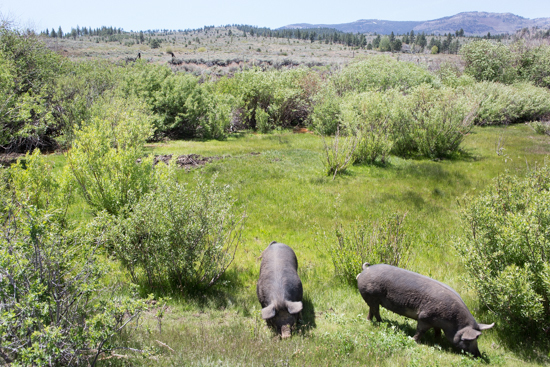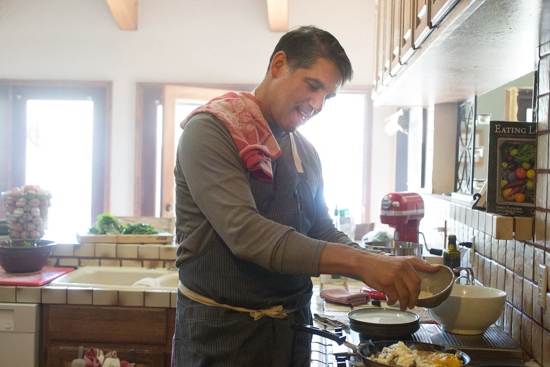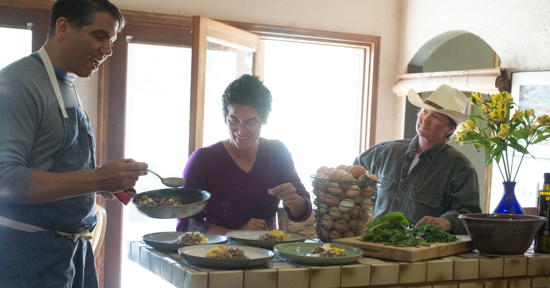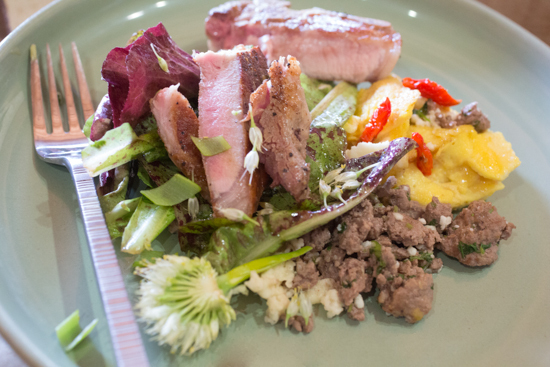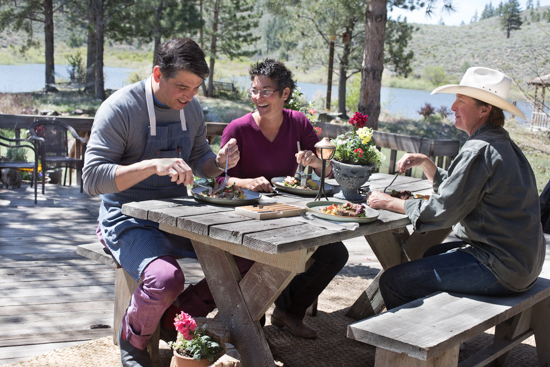Co-authored with Lee Glenn
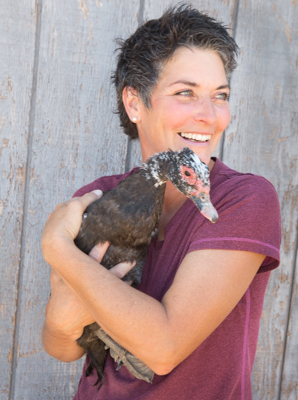 Wendy Baroli owns a small farm outside of Reno. GirlFarm provides Berkshire pork, Jacob lamb, Irish Dexter cattle, chicken, turkey, duck and produce to a CSA of 32 families. In addition, she supplies to local chefs --Mark Estee, a chef and restaurateur is one of those and has worked with Wendy for over three years. Menus from his seven restaurants are developed from what is available at local farms and ranches. He builds his dishes around what is seasonal and fresh.
Wendy Baroli owns a small farm outside of Reno. GirlFarm provides Berkshire pork, Jacob lamb, Irish Dexter cattle, chicken, turkey, duck and produce to a CSA of 32 families. In addition, she supplies to local chefs --Mark Estee, a chef and restaurateur is one of those and has worked with Wendy for over three years. Menus from his seven restaurants are developed from what is available at local farms and ranches. He builds his dishes around what is seasonal and fresh.
Raising livestock on a small farm in Reno is the easy part. The difficulty is finding a USDA approved slaughterhouse nearby, and usually a separate USDA approved facility to cut and package the meat. Back in the day, slaughtering, butchering/fabricating and packaging was done at the same place... but not anymore. Today, this process can be a logistical nightmare of additional issues for the farmer:
- Industrial scale facilities, which can slaughter 390 cattle or 1,100 swine/hour (USDA figures), cannot account for a small farmer's singular head or two.
A small slaughterhouse might kill only 250 cattle per year. This can lead to wait times of over a year for a small farmers harvesting.
For the small farmer, the practice is inefficient, cumbersome and leaves a large carbon footprint. Livestock is trucked to a USDA approved slaughterhouse. After the kill, carcasses are chilled and trucked to a processing facility for butchering and packaging to order. Frequently one or both are in different states than the farm. The final product is trucked back to the farmer to be distributed to customers... no longer exactly local after so many miles.
Understanding this disconnect, Wendy and Mark are joining forces to streamline access to local product and eliminate the extra cost, time and headache. I met them both in the kitchen at GirlFarm and we discussed ways to fix the problem while Mark prepared a delicious hearty farmers brunch using Wendy's farm ingredients: pastured raised Berkshire pork, eggs, freshly picked herbs and greens.
Wendy: "Since the late 60's, Wolf Pack Meats has been owned and run by the University of Nevada, Reno, specializing in professor/student-raised meats. The most important thing the University of Reno, a land-grant university, can do is to serve its public. Today they're struggling to keep up with the demand of the new food movement and accommodate new farmers. Reno needs an expanded USDA approved meat processing facility to help accommodate the growing economy."
"Wolf Pack Meats can do the kill, but they can't do the custom butchering and that stops all of us. They are booked for over a year to harvest animals for local farmers. If you want to get into the business of growing livestock, you have to get in line to have them processed."
"When Great Basin Food Coop calls me requesting a pig I can't fulfill the order because I have to wait to harvest the pig. We need a custom butchery to service the restaurants and the public."
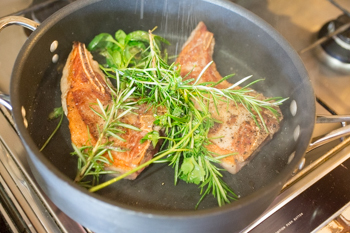 Mark: "I have a great relationship with Wolf Pack Meats. They can kill and refrigerate whole animals all day long, but the cut and packaging takes much more time. They are not geared to do specialty cuts for restaurants and chefs. If the cutting was done elsewhere, we could move the dial with the amount of local meat in our community. This would eliminate the backlog and decrease the wait time for farmers to bring their livestock to harvest."
Mark: "I have a great relationship with Wolf Pack Meats. They can kill and refrigerate whole animals all day long, but the cut and packaging takes much more time. They are not geared to do specialty cuts for restaurants and chefs. If the cutting was done elsewhere, we could move the dial with the amount of local meat in our community. This would eliminate the backlog and decrease the wait time for farmers to bring their livestock to harvest."
Mark is a multi-tasking extraordinaire... talking passionately while seasoning and frying pork chops with basil, rosemary and parsley, scrambling eggs and dressing greens. The aroma makes us all hungry. I ask him how he is handling the situation now and future plans to evolve his own restaurants: Campo Reno, Heritage, Burger Me, and Chez Louie along with Reno's food culture as a whole.
Mark: "I buy two whole pigs per week and have done so for the past 10 years. I want the whole animal because sustainability is important to me and I've grounded my cooking philosophies in the practice of Nose to Tail and Root to Stalk. I utilize every portion of an ingredient."
"Other chefs are starting to embrace this idea. To accommodate the demand, my next project will integrate elements from the different touch points of farm to fork... from a back of house kitchen that will supply local restaurants, to a butchery shop that will concentrate on cured meats and specialty cuts, to educational demonstrations and a retail space that will offer grab and go items. The plan, the design, the vision has no limits. I'm committed to bridging the gap and getting the right products into the hands of chefs to serve their customers."
"We've done a great job on the produce side, but it's hard on the protein side because it's more time consuming and the product isn't always available. I can only go local when Wendy calls to tell me she has pigs being harvested. At that point I will put a hold on standing orders from sources further away."
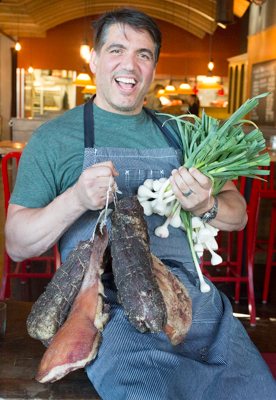 Wendy: "Because of Mark I could grow the farm. Right now I am growing incrementally and I don't promise what I can't deliver. If I want to scale to be sustainable, I have to expand. Though Berkshire litters are smaller and grow slower than the industrialized pink pig, their marbling is what gives this breed its flavor.
Wendy: "Because of Mark I could grow the farm. Right now I am growing incrementally and I don't promise what I can't deliver. If I want to scale to be sustainable, I have to expand. Though Berkshire litters are smaller and grow slower than the industrialized pink pig, their marbling is what gives this breed its flavor.
Comparing the taste differences between a pasture-raised, heritage Berkshire pig and an industrially raised breed, Mark notes: "A heritage breed is like an heirloom tomato... distinguished flavor is not bred out in favor of consistency, faster growth or longer shelf life. The Guanciale, I'm curing from the cheeks of Wendy's breed provides a flavor not found in commercially raised pigs. There is so much fat and fat is flavor. The pink pigs have no marbling. The taste has been bred out of them."
Mark: "Chefs and customers are asking for tastier meats that are sustainably raised. Bringing back heritage meats and rebuilding the chef/rancher relationship is the backbone to making our mission a reality. I'm currently orchestrating a call to action within the Reno-Tahoe Chefs community to define who we are and identify ways to accomplish change. We are rising to the challenge."
To enjoy the fruits of this combined effort, we take our dishes to the kitchen's scenic back porch. The sun is warming the surroundings, while a cool breeze cascades over the water. The sweet smell of pine trees... Girlfarm terroire, heightens the flavors of the dish.
By sharing their mission over a great meal, I'm hopeful other chefs and farmers across America are inspired by their goals.
For a closer look at GirlFarm and Mark Estee: watch this.

